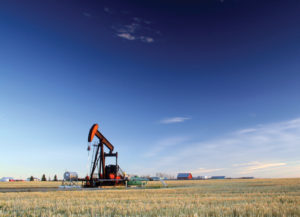It might be said that any land person still breathing and eating in the first quarter of 2021 is either a few pounds lighter or must have won the lottery. That’s because, in an oil price downturn, especially one as sudden and deep as the 2020 model, land services are usually the first to succumb to cost cuts by E&P companies.
At least two land-related firms are alive and leasing—and are putting eyes on a new market that focuses on renewables. Denver-based Landgate (formerly PetroValues) is an online oil and gas properties marketplace that helps mineral owners get a fair price for leases. Landgate digitized the valuation process for oil and gas, creating a new marketplace for minerals, leases, working interest, operatorship, and other components of the business. BearKat Land Services, founded in 2014, is a Permian-focused land firm with offices in Midland and in Dallas.
Changes were already afoot before the pandemic, said Landgate’s President and Director, Craig Kaiser.
“What we’ve seen over the last two years, on the leasing side, is that publicly-traded operators have been very, very slow to lease—very little leasing activity,” he said. “Leasing is almost viewed in the industry at this point as exploration dollars because it’s not guaranteeing you any cash flow.” Exceptions would involve leases necessary for maintaining drilling activity. Most public companies see leasing as an exploration cost instead of development, and that includes properties that are in a previously prized category of PDP (Proved/Developed/Producing).
Actually, all leasing from all companies ground to a halt in April and May, said BearKat’s founder, John D. Dobbs. “We saw capex being slashed to match market conditions, and the first thing to go is the contract landmen. For those first few months, April and May of 2020, you just saw companies divesting non-core assets and trying to raise as much security as they could. A few were actually looking to buy during that time.” But, said Dobbs, “Most groups were going back in their clamshells and weathering the storm.”
Those looking to buy—as opposed to lease—on blue-light specials were disappointed, he noted, because sellers weren’t convinced the panic would last long. If prices were to return in a few months, most felt they could hang on without having to sell strong PDPs to pay the electric bill.
Plus, said Kaiser, strong PDPs were what everyone wanted, and few were for sale at any price. “Everyone’s looking for PDP, and not just any PDP. Everyone’s looking for the exact same type of PDP class, of stable producing, low-decline, safe investment.
“The thing is,” Kaiser continued, “if everyone’s looking for that, there is no opportunity. Those assets don’t exist right now—they’re not for sale because those are the assets that companies are digging their hands into, because they’re the only thing keeping their cash flow alive. Everyone and their dog is bidding on them. So the prices of PDP are absolutely not on the same level of where the commodity price has been since February.”
Dobbs added that it’s not like oil and gas assets have to be sold before an expiration date—they’ll still be there when the price returns to a profitable level. Some companies were overleveraged and were indeed in trouble, but those issues were mostly done with M&As instead of individual tract sales.
There were a few situations where buyers picked up distressed assets, Dobbs explained, but they were rare. Ironically, said Kaiser, “There are some good things out there, but nobody’s looking at them.”
Q4 Saw Activity Pick Up
Both companies observed an uptick in activity by December 2020, as vaccines began to be released and the second stimulus bill was floated, possibly foreshadowing a demand increase by Q1 2021.
Said Dobbs, “The rig count is an indicator of a healthy market, and we’re starting to see the rig count rise, E&Ps are completing their DUCs, and we’re starting to see some spudding of new wells, which is exciting. With that, comes more work for us in land services.”
Many Permian producers have employed efficiencies that make their production profitable at $25-$35 per barrel, and with prices reaching $47 in December, that was seen as a key to the uptick in the rig count.
BearKat is most active on the Texas side of the border due at least in part to two factors. One is the expectation that a Biden presidency will restrict or stop leasing on federal lands—which comprise the vast majority of production in New Mexico. Texas’s production comes almost exclusively from private land or University Lands.
The second factor suppressing New Mexico activity is that the state recently announced a ban on the use of fresh water for completions, Dobbs said. While there is some recycling of produced water for use in fracturing, many producers are concerned that it won’t be enough to supply the huge quantities needed for frac jobs.
The company has also seen activity increasing in the Eagle Ford.
“Clearly, the Permian is still the place to be as far as value and where people are confident in spending money to get a return on it,” said Kaiser. But there has also been an uptick in interest in gas plays—a completely new development. “Since February, what’s really shifted, is interest in East Texas, the Barnett, the Marcellus—Pennsylvania, West Virginia, Ohio—gas assets.”
Before that, natural gas was hardly mentioned as an area of interest for leasing.
With the pandemic shutdowns in 2020, oil prices have tanked, they’re at the bottom, Kaiser pointed out, but now “what people are seeing is a continued demand for natural gas in virtually all segments of the economy. What those people are seeing is that we really haven’t been drilling much for gas assets in the last 10 years, since the price has been down. We’ve been getting a lot of gas out of oil plays. So gas is kind of back in vogue. They don’t see a lot of downward pressure on gas prices, they don’t see it going any lower. There’s a lot of upside with gas. That’s a huge shift we’ve seen—less appetite for oil liquids plays and more towards high quality, not speculative, gas assets.”
No More Buying and Flipping for You
As has been widely reported, the buy-and-flip model was already dying before the dawn of 2020. Investors looking to free-spend their way into buying, growing, and selling a company at a big profit were either losing money or stuck with a company they didn’t want long-term. Stagnant prices and overinvestment collided, and the buy-and-flip investors were some of the first casualties.
So does this mean the end of the shale boom?
“Absolutely not!” Kaiser declared. “It’s a miracle what the shale revolution has done for this country and how much energy we can produce for  ourselves.” But—“The way capital is executed in this industry has to change or the capital is going to go somewhere else.” He listed Blackstone as one major investor looking to place money in companies with better ESG ratings, especially on the governance issue while also, “They want returns on their investment.”
ourselves.” But—“The way capital is executed in this industry has to change or the capital is going to go somewhere else.” He listed Blackstone as one major investor looking to place money in companies with better ESG ratings, especially on the governance issue while also, “They want returns on their investment.”
While the shale revolution as a whole is still alive, Kaiser does hope to see one funeral. “What I hope to see the death of is massive amounts of money going into the industry for just horribly executed or thought-out projects. I hope this is the death of funding going to very poor-performing management teams.” Kaiser saw money given out to companies because the recipients’ only track record was on investment-raising, not because they had made money.
Coming out of this cycle, “I hope, at least on the financial side, what we see is much more thought-out and planned capital execution going in to projects—not just, well this management team has raised $500 million before, and it seems like they’ve got a track record of raising capital—well, do they have a track record of returning capital? That might be the bigger question.”
More Changes in the Future
Many have predicted a near-term shortage in the first two quarters of 2021 as demand could rise faster than wells can be restarted, DUCs completed, and new drilling can get started, driving prices above $55 per barrel. That would especially be good news contract firms like BearKat. “For us, you see a lot of the talent leaves, Dobbs said. This out-migration occurs during busts—with much of the talent never returning to the Patch. “With the uptick in production, the work’s still there. So I think you’ll see a lot of brokers like myself come in to help E&P companies with their daily due diligence, leasing, and just land management services. That would alleviate a lot of the responsibility, once a project’s complete, to keep [permanent employees] on the payroll,” Dobbs added.
The new year may also see a large expansion in what land companies can lease, as renewables become a large piece of the pie. Both Landgate and BearKat listed wind and solar leasing as next steps.
“You have surface leases for these renewables, whether it’s wind or solar,” said Dobbs. “That’s huge—there’s a market for that.” With these new energy initiatives, and the more government subsidies for renewables, there will be more need for leasing surface rights to both entities. Dobbs added that a lot of oil and gas land is also suitable for producing wind and solar power, so a mineral owner could lease both surface and subsurface rights in the near future.
Landgate is also seeing the need and the opportunities in renewables, not just in the Permian Basin. “We’re getting ready to expand into solar energy with almost the exact same thing we do in oil and gas,” Kaiser said. “Landowners will understand, on a relative basis, what their property is worth, from a cash flow perspective, on the solar side. We’ll be rolling out the wind portion of that early next year.”
He sees this as a sea change for land services as a whole. “In my opinion, in the next 4-5 years, you’re not going to have oil and gas mineral buying companies, you’re going to have solar royalty buying companies. I think you’re going to have an amalgamation of energy-buying companies. You’re going to have companies that want to invest in energy projects across the United States regardless of what their asset classes are, whether they’re buying cash flow or PDP, [and] the same thing applies to wind and solar as far as royalties or monthly payments.”
At the end of 2020 Landgate signed up “close to 50-60,000 acres of property across the country for folks that are looking to get a wind lease or a solar lease.” These contracts went to landowners looking to get ahead of the curve.
As curves continue to spin, keeping ahead of them is more and more challenging. But as with most changes, some things are lost but other are gained. For land services, the alternatives—the resources that are wind, solar, and geothermal (eventually)—may be what saves them.
_______________________________________________________________________________
By Paul Wiseman











